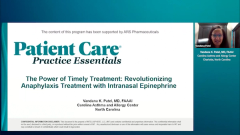
The Clinical Safety and Practical Advantages to Intranasal Epinephrine
A panelist discusses that the intranasal epinephrine device causes only mild, expected adverse effects such as nasal discomfort and headache, avoids injection-related risks, demonstrates rapid symptom improvement in pediatric food challenge studies, and offers practical advantages such as higher heat tolerance for storage and a longer shelf life compared with traditional autoinjectors.
Episodes in this series

Because it’s a nasal spray, common adverse effects are mild and expected, including nasal discomfort, headache, and rhinorrhea (runny nose). No severe adverse effects were reported in clinical trials or in real-world use, whether administered in the office or at home. Because it’s not an injection, there’s no risk of lacerations, bleeding, or infection, which are potential risks with injectable epinephrine.
During the device’s global launch, the Japanese FDA requested additional data on actual use during anaphylaxis. In a study involving 15 patients aged 6 to 17 years undergoing food challenges, intranasal epinephrine was administered once moderate symptoms appeared (eg, coughing, wheezing, shortness of breath, elevated pulse, or gastrointestinal symptoms). The study showed a rapid improvement in symptoms, with significant reduction in severity within 15 to 20 minutes, similar to what is expected with injectable epinephrine.
Additional patient-friendly benefits include easier storage: The intranasal device can safely be stored at higher temperatures (up to 122 °F) compared with injectable epinephrine’s limit of 86 °F. This addresses common concerns about heat exposure in places like cars or sports bags. Plus, the intranasal device has a longer shelf life—approximately 24 to 30 months, depending on the dose—compared with the 12 to 18 months typical for autoinjectors, making it more convenient and cost-effective over time.
Newsletter
Enhance your clinical practice with the Patient Care newsletter, offering the latest evidence-based guidelines, diagnostic insights, and treatment strategies for primary care physicians.





























































































































































































































































































